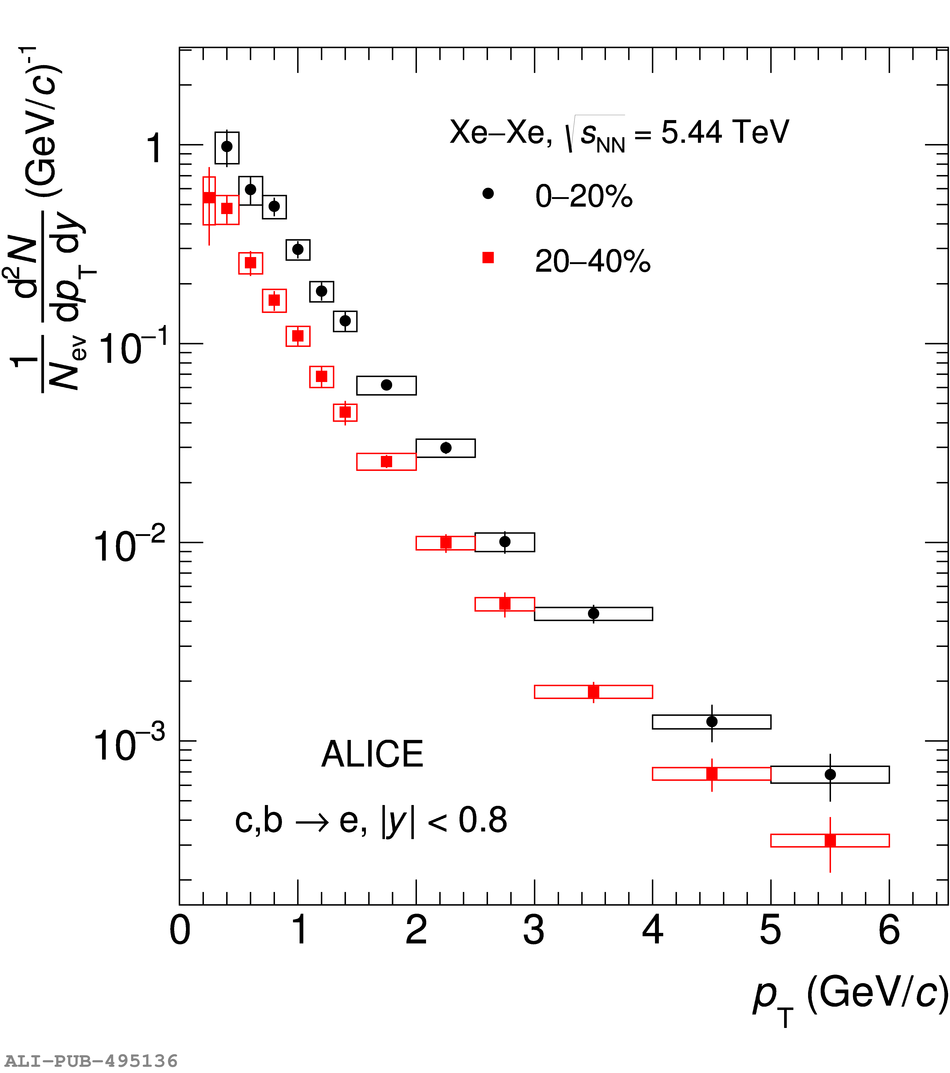The first measurements of the production of muons and electrons from heavy-flavour hadron decays in Xe-Xe collisions at $\sqrt{s_{\rm NN}}$ = 5.44 TeV, using the ALICE detector at the LHC, are reported. The measurement of the nuclear modification factor $R_{\rm AA}$ is performed as a function of transverse momentum $p_{\rm T}$ in several centrality classes at forward rapidity ($2.5 <~ y <~4$) and midrapidity ($\vert y \vert <~ 0.8$) for muons and electrons from heavy-flavour hadron decays, respectively. A suppression by a factor up to about 2.5 compared to the binary-scaled pp reference is observed in central collisions at both central and forward rapidities. The $R_{\rm AA}$ of muons from heavy-flavour hadron decays is compared to previous measurements in Pb-Pb collisions at $\sqrt{s_{\rm NN}}$ = 5.02 TeV. When the nuclear modification factors are compared in the centrality classes 0-10% for Xe-Xe collisions and 10-20% for Pb-Pb collisions, which have similar charged-particle multiplicity density, a similar suppression, with $R_{\rm AA} \sim 0.4$ in the $p_{\rm T}$ interval $4 <~ p_{\rm T} <~ 8$ GeV/$c$, is observed. The comparison of the measured $R_{\rm AA}$ values in the two collision systems brings new insights on the properties of the quark-gluon plasma by investigating the system-size and path-length dependence of medium-induced parton energy loss. The results of muons and electrons from heavy-flavour hadron decays provide new constraints to model calculations.
PLB 819 (2021) 136637
HEP Data
e-Print: arXiv:2011.06970 | PDF | inSPIRE
CERN-EP-2020-208
Figure 1
Figure 2
Nuclear modification factor $\RAA$ of muons from heavy-flavour hadron decays at forward rapidity as a function of $\pT$ in Xe--Xe collisions at$\sqrt{s_{\rm NN}}$ = 5.44 TeV for various centrality intervals mentioned in the figure. Statistical uncertainties (vertical bars) and systematic uncertainties (open boxes) are shown. The filled boxes at $\RAA$ = 1 represent the normalisation uncertainty. Comparisons with the PHSD and MC@sHQ+EPOS2 models are presented. |  |
Figure 3
Nuclear modification factor of electrons from semileptonic heavy-flavour hadron decays as a function of $\pT$ in Xe--Xe collisions at $\sqrt{s_{\rm NN}}$ = 5.44 TeV for the 0--20\% (left panel) and 20--40\% (right panel) centrality intervals. Statistical uncertainties (vertical bars) and systematic uncertainties (open boxes) are shown. The filled boxes at $\RAA$ = 1 represent the normalisation uncertainty. Comparisons with the PHSD , MC@sHQ+EPOS2 and Djordjevic models are displayed. |  |
Figure 4
Comparison of the $\pT$-differential nuclear modification factor of muons from heavy-flavour hadron decays at forward rapidity in Xe--Xe collisions at $\sNN$ = 5.44 TeV (centrality class 0--10\%) and Pb--Pb collisions at $\sNN$ = 5.02 TeV for the 0--10\% (left) and 10--20\% (right) centrality classes. Statistical uncertainties (vertical bars) and systematic uncertainties (open boxes) are shown. The filled boxes at $\RAA$ = 1 represent the normalisation uncertainty. Comparisons with PHSD and MC@sHQ+EPOS2 model predictions are also displayed. |  |


